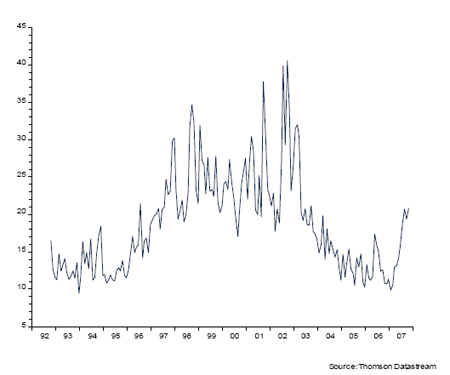$100 oil, interest rates and your gas bill
The oil price edged perilously close to the $100 mark in recent days. Jeremy Batstone Carr looks at the near-term outlook for oil and what it will mean for inflation - and interest rates.
Equity markets remain tense and risk aversion high as we enter the final few trading weeks of 2007. In last week's publication we expressed surprise by the general resilience displayed by equity investors despite the apparent "wall of worry" created by deepening fears regarding the health of the US economy and corresponding weakness in the outlook for corporate earnings.
Adding to those fears are the seemingly ever-present geo-political tensions which have been augmented of late by the build-up of Turkish military forces on that country's border with Iraq.
These tensions, whilst apparently shrugged off by equity markets are showing up in aggregate measures of volatility (see chart below) and in the oil price as futures traders continue to speculate on the impact of a potentially profound supply / demand mis-match.
MoneyWeek
Subscribe to MoneyWeek today and get your first six magazine issues absolutely FREE

Sign up to Money Morning
Don't miss the latest investment and personal finances news, market analysis, plus money-saving tips with our free twice-daily newsletter
Don't miss the latest investment and personal finances news, market analysis, plus money-saving tips with our free twice-daily newsletter
In this note we look at the possible economic consequences of an oil price edging perilously close to $100 per barrel and attempt to explain why this seems not to be hitting the headlines or ruffling too many feathers in the financial market dovecote.
Aggregate Measure of Financial Market Volatility Remains Elevated

First and foremost, global output growth is set to slow further in 2008. having peaked at 5.5% in 2006, output growth is expected to have slowed to c5.0% this year and driven by the ongoing crisis in US residential property, to c4.5% in 2008. The ongoing strength of the Asian and Indian economies has resulted in a prolonged period of unprecedented global prosperity and the incremental demand for oil and other scarce raw materials has added markedly to the supply / demand mis-match which has contributed to the former's recent move to $92.22 per barrel, only about $12 short of the inflation-adjusted levels it reached in the period surrounding the overthrow of the Shah of Iran in 1979. However, US economic activity is expected to slow markedly over the first half of 2008, partly alleviating the demand side of the equation.
Eurozone growth could also disappoint as the region's currency strength continues to hold back exporters. Meanwhile Japan remains perilously close to slipping back into recession and even in China (which, despite all the hoopla, still only accounts for 6% of global Gross Domestic Product (GDP) when measured at market exchange rates not purchasing power parity) the adjustment from an investment and export-driven economy to greater consumer focus is expected to produce some uncomfortable ripples.
The anticipated slowdown in the pace of global growth should serve to take at least part of the pressure off inflation, particularly as central bankers outside the US continue to show few signs of wanting to cut base rates (indeed eurozone and Japanese base rates could rise further). But what about the position here in the UK? The Bank of England has so far resisted pressure to cut base rates and continues to obsess about perceived capacity constraints and the inexorable rise in monetary aggregates.
The targeted measure of domestic inflation has fallen sharply in recent months, reflecting dwindling energy effects from the past. The latest spike in the oil price is likely to be felt most keenly in the price of petrol at the pumps. According to Capital Economics, oil at $85 per barrel is consistent with a price of about £1.02 per litre, an increase of around 7% from prevailing levels. Given petrol's weighting in the inflation calculation this could add about 0.3% to targeted (CPI) inflation. As ever, however, base effects need to be taken into consideration when considering any possible year on year impact. This time last year the price of petrol was falling, thus the combination of an easy "base effect" with a sharp hike in oil prices over the past couple of months could actually add as much as 0.6% to CPI inflation, driving the annualised calculation from 1.8% to 2.4%.
As oil is used in the production of gas and electricity it is reasonable to expect prices to be adversely impacted too. Were gas and electricity prices to increase by the same 50% hike identified in the oil market over the past year this could drive wholesale gas prices to c55 per therm and wholesale electricity prices to c£60 per megawatt. Such an event would almost certainly prompt a response from gas and electricity suppliers. A 5% increase in gas and electricity prices to end users could add c0.2% to overall inflation. However, gas and electricity prices tend to lag the oil price by about a year, therefore this response might not be forthcoming for at least another twelve months and in the interim prices could continue to weaken as last year's higher wholesale utility prices continue to wash through the system.
The consequence is that higher petrol prices are likely to be offset, for the time being, by lower gas and electricity prices, limiting the impact on annualised CPI to about 2.1%. Beyond the direct impact of a higher oil price on other energy markets the picture becomes less clear-cut. If the experience of 2007 is anything to go by those companies facing higher input costs are likely to try and pass those higher costs on to customers in the form of higher prices. How successful this proves to be is likely to depend on the overall health of the economy and consumers' willingness to pay those higher prices. It is already well known that demand for petrol at the pumps is pretty price inelastic.
People may grumble but they do pay the higher price to ensure mobility. Higher pump prices mean less money to spend elsewhere thus we expect pressure on retailers to intensify, hardly good news in the run-up to the all-important Christmas trading season. If consumers do decide to pare spending in the light of already high debt levels and rising pressures elsewhere the overall impact on economic activity could be marked. By contrast, the impact on inflation would be positive and we would not be surprised to see domestic inflationary pressure ease yet further in the next twelve months.
Conclusion
The market has greeted the latest spike in the oil price calmly. Although there are inflationary consequences, base effect adjustments should ensure that the impact is limited. With the risk to domestic economic growth skewed to the downside (and reflected in both Bank and Treasury forecasts) the financial markets have concluded that the present spike in the oil price represents only a limited threat to inflationary pressure. Even at the long-awaited $100 per barrel (which cannot now be ignored) we still view the overall increase in targeted inflation to be limited.
Whilst it may act as a further constraint to a Bank already only to eager to clutch at any justification not to cut base rates, the forthcoming slowdown should prove the dominant influence on Bank thinking and UK base rates will indeed be cut, even if we must now wait until Q1 2008 for it the first such more to take place.
By Jeremy Batstone-Carr, Director of Private Client Research at Charles Stanley
Get the latest financial news, insights and expert analysis from our award-winning MoneyWeek team, to help you understand what really matters when it comes to your finances.
MoneyWeek is written by a team of experienced and award-winning journalists, plus expert columnists. As well as daily digital news and features, MoneyWeek also publishes a weekly magazine, covering investing and personal finance. From share tips, pensions, gold to practical investment tips - we provide a round-up to help you make money and keep it.
-
 Asia's new tiger economy: MoneyWeek Talks
Asia's new tiger economy: MoneyWeek TalksPodcast MoneyWeek's editor, Andrew van Sickle, speaks to Dragon Capital's Thuy-Anh Nguyen about Vietnam's remarkable rise
-
 How much do you need to earn to afford the average rent?
How much do you need to earn to afford the average rent?Rental growth is slowing and making rents more affordable for tenants, but what hwo much do you need to earn to afford the average UK rent?

